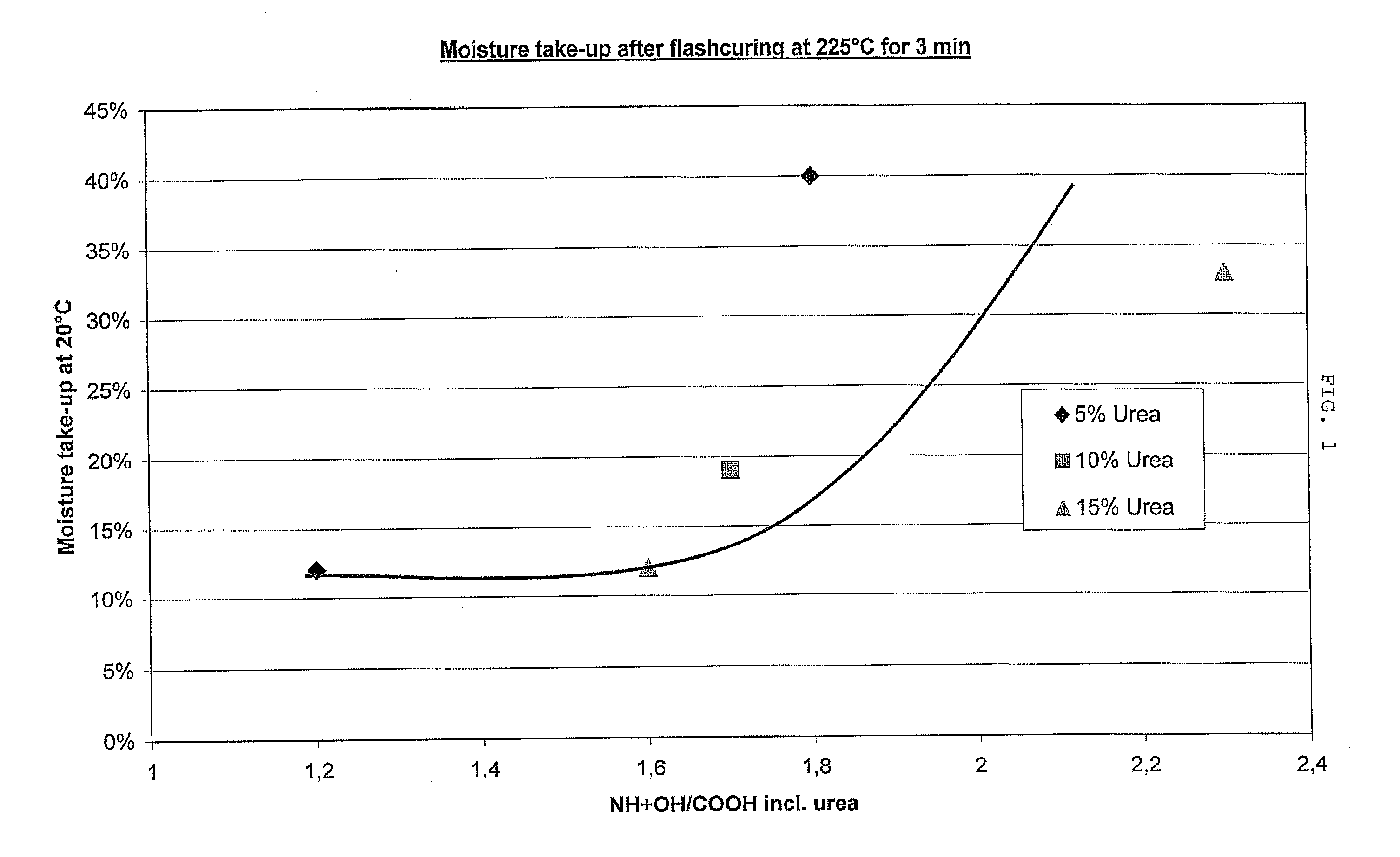Aqueous urea-modified binder for mineral fibers
a technology of mineral fibers and binders, applied in the direction of adhesives, constructions, textiles and paper, etc., can solve the problems of unsatisfactory mechanical strength of bonded mineral fibre products, and achieve the effect of reducing moisture take-up and improving mechanical strength
- Summary
- Abstract
- Description
- Claims
- Application Information
AI Technical Summary
Benefits of technology
Problems solved by technology
Method used
Image
Examples
examples
Reference Example
Preparation of Binder Components A1 to A6
[0051]X g of diethanolamine (DEA) is placed in a 1-litre glass reactor provided with an agitator and a heating / cooling jacket. The temperature of the diethanolamine is raised to 60° C. whereafter Y1 g of tetrahydrophthalic anhydride (THPA) is added. After raising the temperature to and keeping it at 130° C., a second portion of Y2 g of tetrahydrophthalic anhydride is added, followed shortly by addition of Z g of trimellitic anhydride (TMA).
[0052]After reacting for 1 hour, the mixture is cooled to 95° C., W g of water added and the mixture is stirred for 1 hour. After further cooling of the reaction mixture to below 30° C., a binder component A is obtained having an equivalent ratio (NH+OH) / COOH as stated in Table 1 below,
TABLE 1A1A2A3A4A5A6(NH + OH) / 1.01.61.31.61.01.4COOHDEA (X)315 g315 g315 g315 g315 g315 gTHPA (Y1)274 g115 g177 g164 g183 g183 gTHPA (Y2)119 g 58 g 88 g 82 g 91 g 91 gTMA (Z)248 g219 g219 g156 g346 g173 gWater...
examples 1 to 5
Preparation of Binders Nos. 1-5 According to the Present Invention
[0053]For the preparation of binders Nos. 1-5 according the present invention each of the binder components A1 to A5 is mixed With a binder component B which comprises urea in the amounts given in Table 2 below.
[0054]For the preparation of the final binder composition, to each of the compositions Nos. 1-5 is added a curing accelerator (2% based on solids of hypophosphorous acid), a coupling agent (3-aminopropyltriethoxy silane) and ammonia.
TABLE 2Component A(NH + OH) / BinderBinder fromComponent BAmountCOOHNo.Ref. ExampleUreaof ureaafter urea1A140 g4.65 g15%1.62A240 g4.22 g15%2.33A340 g2.76 g10%1.74A440 g1.25 g5%1.85A540 g1.14 g5%1.2
example 6
Procedure for Making Gritbars
[0056]90 ml of binder solution adjusted to 15% solids are mixed with 450 g of shots. Out of the 450 g shots, 8 bars are made which are cured at 200° C. for 2 hours.
[0057]On 4 of the bars, the 3-point bending strength is measured directly (dry strength), on the other 4 bars after aging by submersion of the bars in 80° C. hot water for 3 hours (aged strength).
Moisture Take-Up
[0058]Approx. 0.5 g of binder solution having a solids content of about 25% (determined by curing at 200° C. for 1 hour) is evenly spread over a quartz filter.
[0059]The filter is placed in a flash curing apparatus and cured at 225° C. for 3 minutes at a differential pressure over the filter of 190 mm water column.
[0060]After curing, the filter is placed above 20-30 ml of ion-exchanged water in a plastic beaker with lid. The beaker is placed in a heating cupboard at 20° C., i.e. humidity conditions are 20° C., 100% RH.
[0061]The filter is weighed before application of binder, before and ...
PUM
| Property | Measurement | Unit |
|---|---|---|
| temperature | aaaaa | aaaaa |
| temperature | aaaaa | aaaaa |
| temperature | aaaaa | aaaaa |
Abstract
Description
Claims
Application Information
 Login to View More
Login to View More - R&D
- Intellectual Property
- Life Sciences
- Materials
- Tech Scout
- Unparalleled Data Quality
- Higher Quality Content
- 60% Fewer Hallucinations
Browse by: Latest US Patents, China's latest patents, Technical Efficacy Thesaurus, Application Domain, Technology Topic, Popular Technical Reports.
© 2025 PatSnap. All rights reserved.Legal|Privacy policy|Modern Slavery Act Transparency Statement|Sitemap|About US| Contact US: help@patsnap.com



